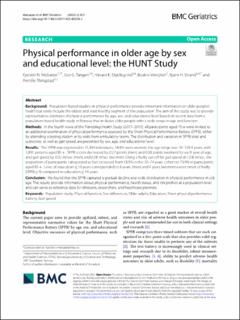| dc.description.abstract | Background
Population-based studies on physical performance provide important information on older people’s health but rarely include the oldest and least-healthy segment of the population. The aim of this study was to provide representative estimates of physical performance by age, sex, and educational level based on recent data from a population-based health study in Norway that includes older people with a wide range in age and function.
Methods
In the fourth wave of the Trøndelag Health Study (2017–2019), all participants aged 70 + were invited to an additional examination of physical performance assessed by the Short Physical Performance Battery (SPPB), either by attending a testing station or by visits from ambulatory teams. The distribution and variation in SPPB total and subscores, as well as gait speed, are presented by sex, age, and educational level.
Results
The SPPB was registered in 11,394 individuals; 54.8% were women; the age range was 70–105.4 years, with 1,891 persons aged 85 + . SPPB scores decreased by 0.27 points (men) and 0.33 points (women) for each year of age, and gait speed by 0.02 m/sec (men) and 0.03 m/sec (women). Using a frailty cut-off for gait speed at < 0.8 m/sec, the proportion of participants categorized as frail increased from 13.9% in the 70–74 years cohort to 73.9% in participants aged 85 + . Level of education ≤
10 years corresponded to 6 years (men) and 4 years (women) earlier onset of frailty (SPPB ≤
9) compared to education ≥
14 years.
Conclusion
We found that the SPPB captured a gradual decline and wide distribution in physical performance in old age. The results provide information about physical performance, health status, and risk profiles at a population level and can serve as reference data for clinicians, researchers, and healthcare planners. | en_US |

